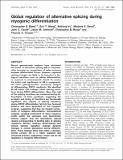Global regulation of alternative splicing during myogenic differentiation
Author(s)
Bland, Christopher S.; Vu, Anthony; David, Marjorie P.; Castle, John C.; Johnson, Jason M.; Cooper, Thomas A.; Wang, Eric T; Burge, Christopher B; ... Show more Show less
Downloadmain article (6.539Mb)
PUBLISHER_CC
Publisher with Creative Commons License
Creative Commons Attribution
Terms of use
Metadata
Show full item recordAbstract
Recent genome-wide analyses have elucidated the extent of alternative splicing (AS) in mammals, often focusing on comparisons of splice isoforms between differentiated tissues. However, regulated splicing changes are likely to be important in biological transitions such as cellular differentiation, or response to environmental stimuli. To assess the extent and significance of AS in myogenesis, we used splicing-sensitive microarray analysis of differentiating C2C12 myoblasts. We identified 95 AS events that undergo robust splicing transitions during C2C12 differentiation. More than half of the splicing transitions are conserved during differentiation of avian myoblasts, suggesting the products and timing of transitions are functionally significant. The majority of splicing transitions during C2C12 differentiation fall into four temporal patterns and were dependent on the myogenic program, suggesting that they are integral components of myogenic differentiation. Computational analyses revealed enrichment of many sequence motifs within the upstream and downstream intronic regions near the alternatively spliced regions corresponding to binding sites of splicing regulators. Western analyses demonstrated that several splicing regulators undergo dynamic changes in nuclear abundance during differentiation. These findings show that within a developmental context, AS is a highly regulated and conserved process, suggesting a major role for AS regulation in myogenic differentiation.
Date issued
2010-07Department
Whitaker College of Health Sciences and Technology; Massachusetts Institute of Technology. Department of BiologyJournal
Nucleic Acids Research
Publisher
Oxford University Press
Citation
Bland, C. S. et al. “Global regulation of alternative splicing during myogenic differentiation.” Nucleic Acids Research 38 (2010): 7651-7664.
Version: Final published version
ISSN
0305-1048
1362-4962